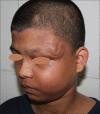Peripheral Arteriovenous Malformations-A Case Series
- PMID: 32695695
- PMCID: PMC7367563
- DOI: 10.4103/idoj.IDOJ_207_19
Peripheral Arteriovenous Malformations-A Case Series
Abstract
Context: Arteriovenous malformations (AVMs) are aggressive vascular malformations that often result in significant morbidity. Patients may present to a dermatologist due to associated skin changes. Early diagnosis is important as treatment is available to halt their progression toward irreversible destruction of adjacent tissues.
Aims: To study the clinical profile of peripheral AVMs presenting to the dermatologist and to provide a diagnostic algorithm.
Settings and design: A retrospective study of patients of all age groups with peripheral AVMs who presented to the Department of Dermatology at a tertiary care hospital in India was performed. Syndromic forms were also included.
Subjects and methods: We conducted a search of patients with peripheral AVMs, which were seen over a period of 51 months, i.e., from July 2014 to September 2018, from electronic medical records and reviewed their clinical details.
Statistical analysis used: Descriptive statistics such as frequency, mean, and median were computed.
Results: We report a series of 13 patients with peripheral AVMs, which constituted 6.7% (13/193) of all vascular malformations during this period. Of these, 8.3% (1/12) belonged to Schobinger's stage 1, 41.7% (5/12) to stage 2, 50% (6/12) to stage 3, and one with subcutaneous involvement devoid of cutaneous changes. The most common location was the extremities, which was seen in 53.8% (7/13). Syndromic association was present in 46.2% (6/13). Management included embolization, surgery, and medical treatment.
Conclusions: The proportion of peripheral AVMs out of all vascular malformations was similar to reported studies. The extremities were more frequently involved as compared to the head and neck. The diagnostic algorithm provided will help us to optimize investigations and direct early management.
Keywords: Angiogram; embolization; peripheral arteriovenous malformations; syndromic.
Copyright: © 2020 Indian Dermatology Online Journal.
Conflict of interest statement
There are no conflicts of interest.
Figures







References
LinkOut - more resources
Full Text Sources

